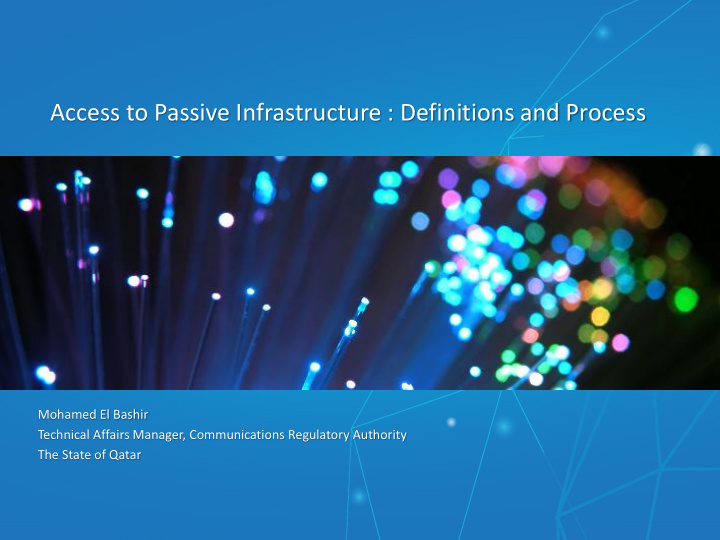



Access to Passive Infrastructure : Definitions and Process Mohamed El Bashir Technical Affairs Manager, Communications Regulatory Authority The State of Qatar
Passive Infrastructure : Distribution Network Internet Users demand high bandwidth ( e.g telecommuting, HD TV, Multimedia sharing, … etc ) Last mile fiber deployment is key to provide high broadband capacity 50-80%, is civil work which involve costs associated with opening (and closing) trenches and laying ducts * Source : OECD Report “ PUBLIC RIGHTS OF WAY FOR FIBRE DEPLOYMENT TO THE HOME”
Passive Networks : Core and Access Passive Optical Network “PON”, uses optical splitters to separate and collect optical signals as they move through the network Gigabit Passive Optical Network “GPON”, Point to Multipoint Distribution Mechanism Shared downstream capacity ( 2.488 Gbps ), upstream capacity (1.244 Gbps ) Distribution Network depend on civil works ( e.g Ducts, manholes, cabinets, telecommunications rooms ..etc )
Telecom Ducts Network Telecom Corridors : constructed on one or both sides of new or some existing Integral part of Public Roads/Highways Telecom Ducts and Infrastructure installed in the Corridor Private Developments
Roles and Responsibilities CRA Infrastructure Telecom Corridor Construction/RO Regulatory - Design and - Access and Sharing - Construction of Standards of Utilities - RO and Design Corridors Roads/Telcom Approvals Corridor - Fiber Rollout “MMUP Roads Cross - Standards for Section Guidene” - Right of Way process Infrastructure “Qatar Highway - Quality of Service Q-PRO Access and Sharing Design manual” Obligations - Concept Designs - Coordination with Approvals ( Q-DES ) Gov. Agencies - Dimensioning of Telecom Corridor - Mega Developments
Right of Way Process Effective RO Process : A one stop shop and administrative procedures Reducing barriers for obtaining authorization for access Harmonizing administrative procedures for RO and ensuring consistency Ashghal manages a RO automated/work flow online System “Q -PRO ” Systems utilize GIS mapping of Utilities Infrastructure System Users : Utility Agencies, Telecom Providers, Contractors Ensure all procedures are online , SLA for better performance
Passive Infrastructure Regulatory Issues Efficient, easy, a quick Right of Way ( ROA ) Access/Access to Ducts and Associated Civil Infrastructure “Technical Standards for Fixed Infrastructure Rollout” Access/Sharing of Telecom Infrastructure in Mega Projects and Developments Lack of Clear Rules and Responsibilities
Passive Infrastructure Access and Sharing What is OPEN ACCESS ? The possibility for third parties to use an existing network infrastructure Ensuring access on fair, reasonable and non-discriminatory terms OPEN ACCESS Models : Government/Private Partnership ( Australia, Qatar, Malysia, Singapore ) NBNs Fibre Deployment ( Core to Customer access Networks ) Improve investment incentives for network operators ( Europe ) Hybrid Gov. Funding (Low Interest, Long Term ) and Private Funding ( Africa ) OPEN ACCESS : Co-Locations (e.g Telecom rooms, exchanges, ..etc ) Civil Infrastructure ( e.g Ducts, leading ducts, ..etc )
Way Forward Automated, Quick, Efficient ROW Process Technical Standards for Access and Sharing of Passive Infrastructure Ability to get access to Ducts Networks ( Private/Government )
Passive Infrastructure Who Shares Wins
Thank You
Recommend
More recommend